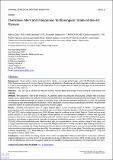Files in this item
Overdose alert and response technologies : state-of-the-art review
Item metadata
| dc.contributor.author | Oteo, Alberto | |
| dc.contributor.author | Daneshvar, Hadi | |
| dc.contributor.author | Baldacchino, Alexander Mario | |
| dc.contributor.author | Matheson, Catriona | |
| dc.date.accessioned | 2023-02-16T13:30:05Z | |
| dc.date.available | 2023-02-16T13:30:05Z | |
| dc.date.issued | 2023-02-15 | |
| dc.identifier | 283384172 | |
| dc.identifier | e77523c4-a4de-44d1-9f69-666f43e9aa01 | |
| dc.identifier | 36790860 | |
| dc.identifier | 36790860 | |
| dc.identifier | 85148250674 | |
| dc.identifier.citation | Oteo , A , Daneshvar , H , Baldacchino , A M & Matheson , C 2023 , ' Overdose alert and response technologies : state-of-the-art review ' , Journal of Medical Internet Research , vol. 25 , e40389 . https://doi.org/10.2196/40389 , https://doi.org/10.2196/40389 | en |
| dc.identifier.issn | 1439-4456 | |
| dc.identifier.other | PubMedCentral: PMC9978985 | |
| dc.identifier.uri | https://hdl.handle.net/10023/26995 | |
| dc.description | Funding: Technology Enabled Care program of the Scottish Government. | en |
| dc.description.abstract | Background: Drug overdose deaths, particularly from opioids, are a major global burden, with 128,000 deaths estimated in 2019. Opioid overdoses can be reversed through the timely administration of naloxone but only if responders are able to administer it. There is an emerging body of research and development in technologies that can detect the early signs of an overdose and facilitate timely responses. Objective: Our aim was to identify and classify overdose-specific digital technologies being developed, implemented, and evaluated. Methods: We conducted a “state-of-the-art review.” A systematic search was conducted in MEDLINE, Embase, Web of Science, Scopus, ACM, IEEE Xplore, and SciELO. We also searched references from articles and scanned the gray literature. The search included terms related to telehealth and digital technologies, drugs, and overdose and papers published since 2010. We classified our findings by type of technology and its function, year of publication, country of study, study design, and theme. We performed a thematic analysis to classify the papers according to the main subject. Results: Included in the selection were 17 original research papers, 2 proof-of-concept studies, 4 reviews, 3 US government grant registries, and 6 commercial devices that had not been named in peer-reviewed literature. All articles were published between 2017 and 2022, with a marked increase since 2019. All were based in or referred to the United States or Canada and concerned opioid overdose. In total, 39% (9/23) of the papers either evaluated or described devices designed to monitor vital signs and prompt an alert once a certain threshold indicating a potential overdose has been reached. A total of 43% (10/23) of the papers focused on technologies to alert potential responders to overdoses and facilitate response. In total, 48% (11/23) of the papers and 67% (4/6) of the commercial devices described combined alert and response devices. Sensors monitor a range of vital signs, such as oxygen saturation level, respiratory rate, or movement. Response devices are mostly smartphone apps enabling responders to arrive earlier to an overdose site. Closed-loop devices that can detect an overdose through a sensor and automatically administer naloxone without any external intervention are still in the experimental or proof-of-concept phase. The studies were grouped into 4 themes: acceptability (7/23, 30%), efficacy or effectiveness (5/23, 22%), device use and decision-making (3/23, 13%), and description of devices (6/23, 26%). Conclusions: There has been increasing interest in the research and application of these technologies in recent years. Literature suggests willingness to use these devices by people who use drugs and affected communities. More real-life studies are needed to test the effectiveness of these technologies to adapt them to the different settings and populations that might benefit from them. | |
| dc.format.extent | 16 | |
| dc.format.extent | 262434 | |
| dc.language.iso | eng | |
| dc.relation.ispartof | Journal of Medical Internet Research | en |
| dc.subject | Drug overdose | en |
| dc.subject | Technology | en |
| dc.subject | Opioids | en |
| dc.subject | Telemedicine | en |
| dc.subject | Mobile health | en |
| dc.subject | mHealth | en |
| dc.subject | Apnea | en |
| dc.subject | Sensor | en |
| dc.subject | Naloxone | en |
| dc.subject | Mobile phone | en |
| dc.subject | RA0421 Public health. Hygiene. Preventive Medicine | en |
| dc.subject | T Technology (General) | en |
| dc.subject | SDG 3 - Good Health and Well-being | en |
| dc.subject | MCC | en |
| dc.subject.lcc | RA0421 | en |
| dc.subject.lcc | T1 | en |
| dc.title | Overdose alert and response technologies : state-of-the-art review | en |
| dc.type | Journal item | en |
| dc.contributor.sponsor | Scottish Government | en |
| dc.contributor.institution | University of St Andrews. Population and Behavioural Science Division | en |
| dc.contributor.institution | University of St Andrews. School of Medicine | en |
| dc.contributor.institution | University of St Andrews. Centre for Minorities Research (CMR) | en |
| dc.identifier.doi | 10.2196/40389 | |
| dc.description.status | Peer reviewed | en |
| dc.identifier.grantnumber | N/A | en |
This item appears in the following Collection(s)
Items in the St Andrews Research Repository are protected by copyright, with all rights reserved, unless otherwise indicated.

